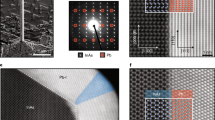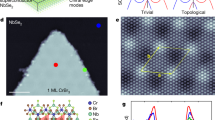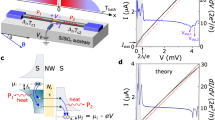Abstract
Epitaxial semiconductor–superconductor hybrid materials are an excellent basis for studying mesoscopic and topological superconductivity, as the semiconductor inherits a hard superconducting gap while retaining tunable carrier density1. Here, we investigate double-quantum-dot structures made from InAs nanowires with a patterned epitaxial Al two-facet shell2 that proximitizes two gate-defined segments along the nanowire. We follow the evolution of mesoscopic superconductivity and charging energy in this system as a function of magnetic field and voltage-tuned barriers. Interdot coupling is varied from strong to weak using side gates, and the ground state is varied between normal, superconducting and topological regimes by applying a magnetic field. We identify the topological transition by tracking the spacing between successive co-tunnelling peaks as a function of axial magnetic field3 and show that the individual dots host weakly hybridized Majorana modes.
This is a preview of subscription content, access via your institution
Access options
Subscribe to this journal
Receive 12 print issues and online access
$259.00 per year
only $21.58 per issue
Buy this article
- Purchase on Springer Link
- Instant access to full article PDF
Prices may be subject to local taxes which are calculated during checkout




Similar content being viewed by others
References
Chang, W. et al. Hard gap in epitaxial semiconductor–superconductor nanowires. Nat. Nanotech. 10, 232–236 (2015).
Krogstrup, P. et al. Epitaxy of semiconductor–superconductor nanowires. Nat. Mater. 14, 400–406 (2015).
Albrecht, S. M. et al. Exponential protection of zero modes in Majorana islands. Nature 531, 206–209 (2016).
Oreg, Y., Refael, G. & von Oppen, F. Helical liquids and Majorana bound states in quantum wires. Phys. Rev. Lett. 105, 177002 (2010).
Lutchyn, R. M., Sau, J. D. & Das Sarma, S. Majorana fermions and a topological phase transition in semiconductor–superconductor heterostructures. Phys. Rev. Lett. 105, 077001 (2010).
Aasen, D. et al. Milestones toward Majorana-based quantum computing. Phys. Rev. X 6, 031016 (2015).
Freedman, M. H., Kitaev, A., Larsen, M. J. & Wang, Z. Topological quantum computation. Bull. Am. Math. Soc. 40, 31–38 (2003).
Nayak, C., Simon, S. H., Stern, A., Freedman, M. & Das Sarma, S. Non-Abelian anyons and topological quantum computation. Rev. Mod. Phys. 80, 1083–1159 (2008).
Mourik, V. et al. Signatures of Majorana fermions in hybrid superconductor–semiconductor nanowire devices. Science 336, 1003–1007 (2012).
Deng, M. T. et al. Anomalous zero-bias conductance peak in a Nb–InSb nanowire–Nb hybrid device. Nano Lett. 12, 6414–6419 (2012).
Das, A. et al. Zero-bias peaks and splitting in an Al–InAs nanowire topological superconductor as a signature of Majorana fermions. Nat. Phys. 8, 887–895 (2012).
Churchill, H. O. H. et al. Superconductor–nanowire devices from tunneling to the multichannel regime: zero-bias oscillations and magnetoconductance crossover. Phys. Rev. B 87, 241401 (2013).
Nadj-Perge, S. et al. Observation of Majorana fermions in ferromagnetic atomic chains on a superconductor. Science 346, 602–607 (2014).
Fasth, C., Fuhrer, A., Björk, M. T. & Samuelson, L. Tunable double quantum dots in InAs nanowires defined by local gate electrodes. Nano Lett. 5, 1487–1490 (2005).
van der Wiel, W. G. et al. Electron transport through double quantum dots. Rev. Mod. Phys. 75, 1–22 (2002).
Tuominen, M. T., Hergenrother, J. M., Tighe, T. S. & Tinkham M. Experimental evidence for parity-based 2e periodicity in a superconducting single-electron tunneling transistor. Phys. Rev. Lett. 69, 1997–2000 (1992).
Bibow, E., Lafarge, P. & Lévy, L. P. Resonant Cooper pair tunneling through a double-island qubit. Phys. Rev. Lett. 88, 017003 (2002).
Higginbotham, A. P. et al. Parity lifetime of bound states in a proximitized semiconductor nanowire. Nat. Phys. 11, 1017–1021 (2015).
Waugh, F. R. et al. Single-electron charging in double and triple quantum dots with tunable coupling. Phys. Rev. Lett 75, 705–708 (1995).
Kouwenhoven, L. P. et al. Electron Transport in Quantum Dots (Kluwer Academic, 1997).
Livermore, C., Crouch, C. H., Westervelt, R. M., Campman, K. L. & Gossard, A. C. The Coulomb blockade in coupled quantum dots. Science 274, 1332–1335 (1996).
Hu, Y. et al. A Ge/Si heterostructure nanowire-based double quantum dot with integrated charge sensor. Nat. Nanotech. 2, 622–625 (2007).
Waugh, F. R. et al. Measuring interactions between tunnel-coupled quantum dots. Phys. Rev. B 53, 1423–1420 (1996).
Larsen, T. W. et al. A semiconductor nanowire-based superconducting qubit. Phys. Rev. Lett. 115, 127001 (2015).
De Franceschi, S., Kouwenhoven, L., Schönenberger, C. & Wernsdorfer, W. Hybrid superconductor–quantum dot devices. Nat. Nanotech. 5, 703–711 (2010).
Lafarge, P., Joyez, P., Esteve, D., Urbina, C. & Devoret, M. H. Two-electron quantization of the charge on a superconductor. Nature 365, 422–424 (1993).
Feigelman, M. V., Kamenev, A., Larkin, A. I. & Skvortsov, M. A. Weak charge quantization on a superconducting island. Phys. Rev. B 66, 054502 (2002).
Lafarge, P., Joyez, P., Esteve, D., Urbina, C. & Devoret, M. H. Measurement of the even–odd free-energy difference of an isolated superconductor. Phys. Rev. Lett. 70, 994–997 (1993).
Averin, D. V. & Nazarov, Y. V. Single-electron charging of a superconducting island. Phys. Rev. Lett. 69, 1993–1996 (1992).
van Heck, B., Lutchyn, R. M. & Glazman, L. I. Conductance of a proximitized nanowire in the Coulomb blockade regime. Phys. Rev. B 93, 235431 (2016).
Das Sarma, S., Sau, J. D. & Stanescu, T. D. Splitting of the zero-bias conductance peak as smoking gun evidence for the existence of the Majorana mode in a superconductor–semiconductor nanowire. Phys. Rev. B 86, 220506 (2012).
Kitaev, A. Y. Unpaired Majorana fermions in quantum wires. Phys. Usp. 44, 131–136 (2001).
Rainis, D., Trifunovic, L., Klinovaja, J. & Loss, D. et al. Towards a realistic transport modeling in a superconducting nanowire with Majorana fermions. Phys. Rev. B 87, 024515 (2013).
Stanescu, T. D., Lutchyn, R. M. & Das Sarma, S. Dimensional crossover in spin–orbit-coupled semiconductor nanowires with induced superconducting pairing. Phys. Rev. B 87, 094518 (2013).
Acknowledgements
The authors acknowledge support from the Danish National Research Foundation and Microsoft Research. C.M.M. acknowledges support from the Villum Foundation.
Author information
Authors and Affiliations
Contributions
P.K. and J.N. developed the nanowire materials. D.S. fabricated the devices. D.S., J.S.Y. and S.M.A. carried out the measurements with input from C.M.M. D.S. analysed the data. D.S., J.S.Y. and C.M.M. wrote the paper. All authors discussed the results and commented on the manuscript.
Corresponding author
Ethics declarations
Competing interests
The authors declare no competing financial interests.
Rights and permissions
About this article
Cite this article
Sherman, D., Yodh, J., Albrecht, S. et al. Normal, superconducting and topological regimes of hybrid double quantum dots. Nature Nanotech 12, 212–217 (2017). https://doi.org/10.1038/nnano.2016.227
Received:
Accepted:
Published:
Issue Date:
DOI: https://doi.org/10.1038/nnano.2016.227
This article is cited by
-
Quantum transport in topological semimetals under magnetic fields (III)
Frontiers of Physics (2023)
-
Recent progress on Majorana in semiconductor-superconductor heterostructures—engineering and detection
Science China Physics, Mechanics & Astronomy (2023)
-
Subgap dynamics of double quantum dot coupled between superconducting and normal leads
Scientific Reports (2021)
-
Yu–Shiba–Rusinov screening of spins in double quantum dots
Nature Communications (2018)
-
Andreev molecules in semiconductor nanowire double quantum dots
Nature Communications (2017)



